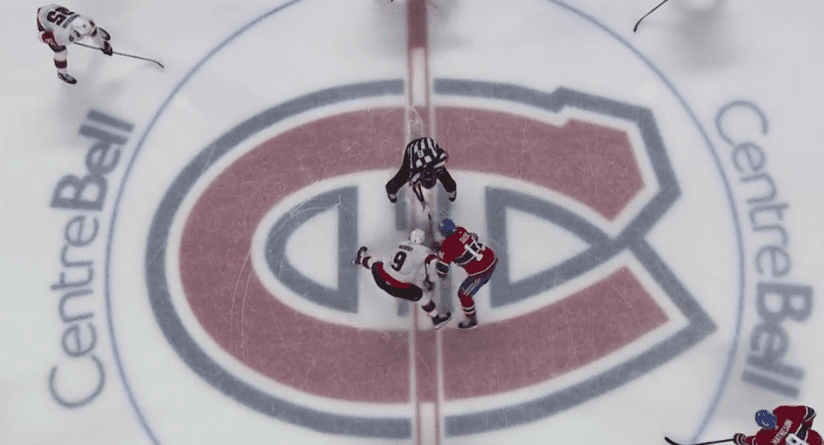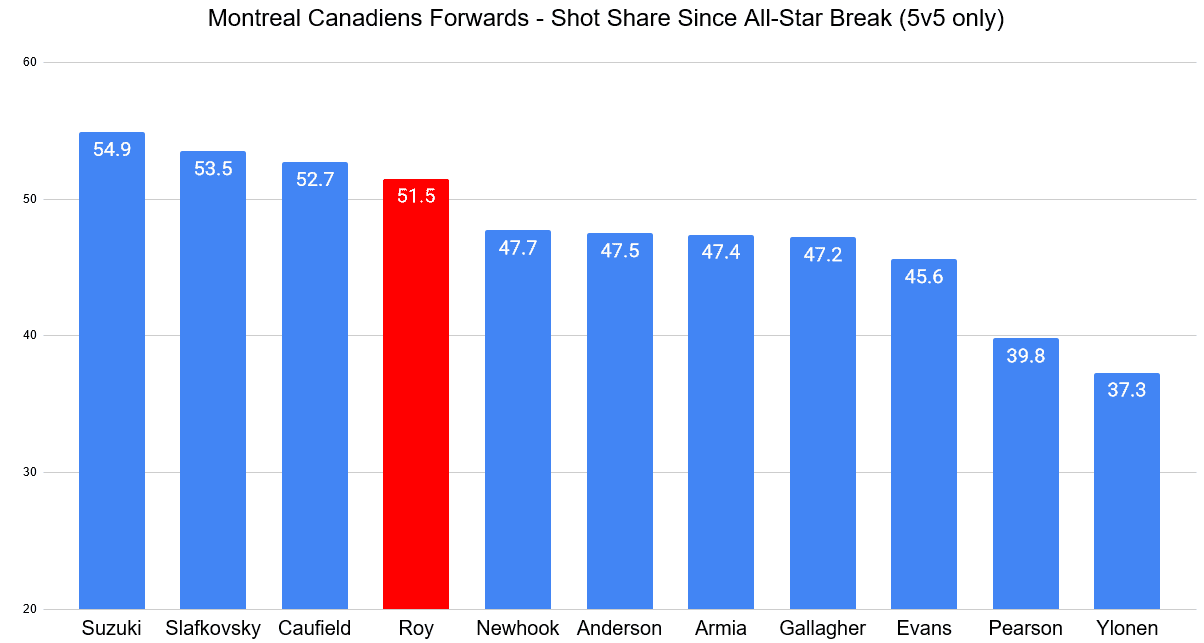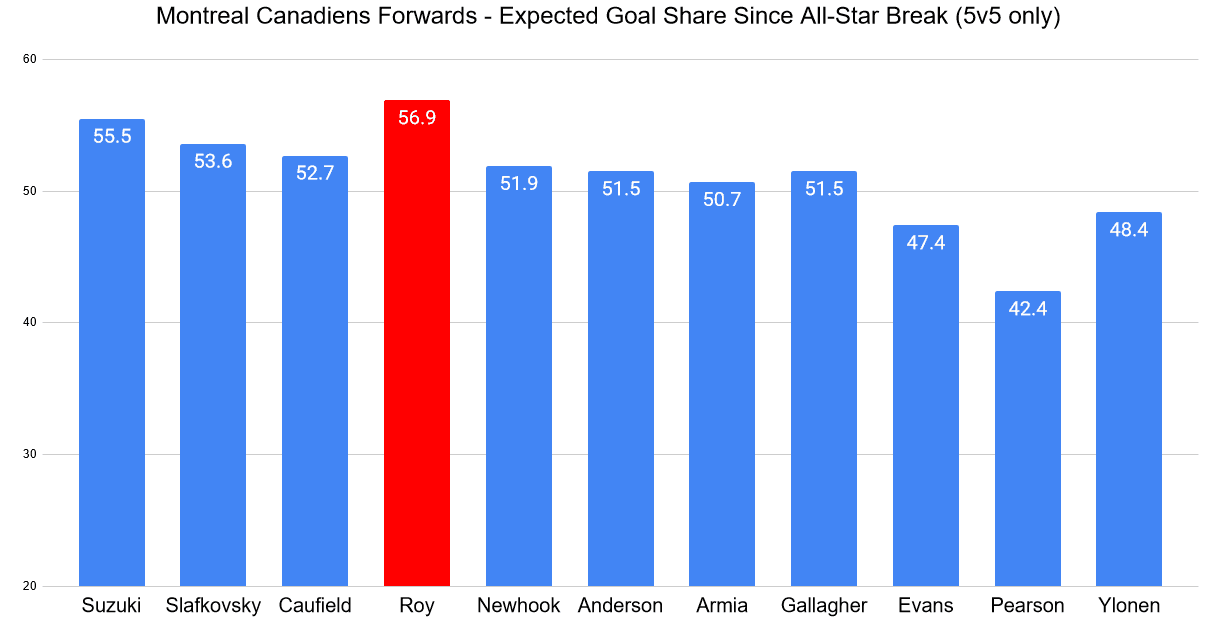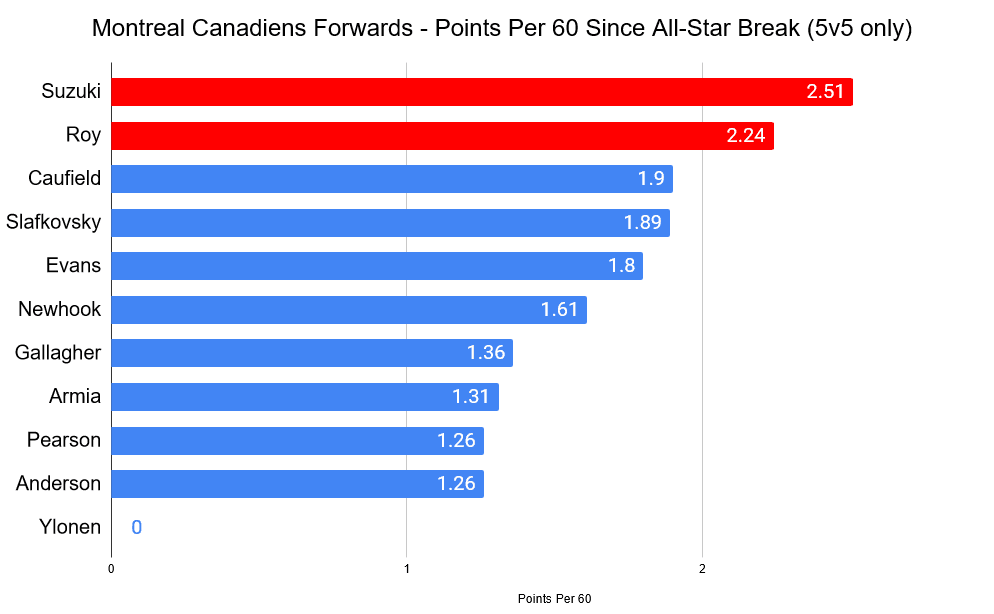Canadiens Analysis
Montreal Canadiens Top Forwards Since All-Star Break

The Montreal Canadiens have been producing very interesting results in the second half of the season.
As previously discussed, the process has improved by leaps and bounds, an encouraging sign for any team amid a rebuild.
With that in mind, we’ll narrow down our information to establish which forwards are driving the offence when it comes to their underlying numbers and their production at 5v5 since the All-Star break.
Montreal Canadiens Forwards By The Numbers
The first statistic we’ll evaluate is their shot share. This is commonly expressed as the Corsi for percentage (CF%). It’s a metric that includes all shots, rather than just shots that hit the net. Only the forwards who played more than 100 minutes of ice time at 5v5 are included in the analysis.
It’s clear that Nick Suzuki, Juraj Slafkovsky, and Cole Caufield are doing the bulk of the work when it comes to gaining an advantage in shot share. The top line has slowed its production recently, but it remains the team’s best trio by a wide margin.
Beyond those three, only Joshua Roy has managed to control more than 50 percent of the shots while he’s on the ice. Unfortunately, the Habs recently announced Roy will be held out of action indefinitely after he blocked a shot with his right hand.
Losing a rookie drafted in the fifth round usually wouldn’t have a significant impact on the lineup, but Roy is already among the team’s best forwards.
Unsurprisingly, Jake Evans, Tanner Pearson, and Jesse Ylonen have had a difficult time when it comes to maintaining possession of the puck, and have been outshot regularly. This aligns perfectly with the ‘eye test’, as fans would have a difficult time remembering plays in which those three spent a lot of time pressuring opponents in the offensive zone rather than defending.
Montreal Canadiens Forwards Expected Goal Share
The next metric we’ll take a look at is the individual expected goal shares (xGF%). This number is produced by including several different data points, including shot location and the type of shot. This gives us a better idea of how the players should perform going forward. For ease of comparison, we kept the players in the same order as they were listed for CF%.
As expected, the top-line players are among the best on the team when it comes to their xGF%, however, Roy has managed to do an even better job while playing with a lower-quality of teammate (QoT). Of course, the first line faces the opposing team’s best players on most nights, and that certainly has an impact on their results, but in hockey, the QoT will always reign supreme.
After the golden four, we’re seeing the middle-of-the-pack players surge beyond 50 percent, yet another very encouraging sign for the rebuild. From the start of the season until the All-Star break, only two forwards (Joel Armia and Brendan Gallagher) had managed to rise above 50 percent.
Montreal Canadiens Forward Production Since All-Star Break
The third number we’ll look at is a little more straightforward than the last two. Having excellent underlying numbers is one thing, but in the long run, you need your forwards to produce at 5v5 if the team is to take the next step.
In the interest of fairness, we’ll also keep their ice time in mind. The numbers listed below are per 60 minutes of ice time at 5v5.
Suzuki’s numbers have skyrocketed this season, which is why you’ll see some people suggest he merits consideration for the Selke trophy. It’s not particularly surprising when you consider this is the first season in which Suzuki has had relatively high-end linemates and some semblance of consistency.
And while his 2.5 P/60 is impressive, we’d be remiss if we didn’t give Roy his fair share of the praise.
Not only is he a top player when it comes to possession numbers, but he only trails the team’s captain when it comes to production, and he’s doing so with a lower QoT than Suzuki.
Brass Tacks
It’s clear which players will bring long-term value to the table.
The Montreal Canadiens are one of the youngest teams in the league, and they’re being led by some of the youngest players in the lineup.
This bodes extremely well for the rebuild.
I still maintain the team needs more offensive talent, particularly a player who has a penchant for taking high-quality shots, but for now, fans can rest easy knowing the youngest forwards are also by far and away the best forwards in the lineup.
And though Roy has the least professional hockey experience of any forward, removing him from the equation will be a big blow to the team’s offensive capabilities.
Tomorrow, we’ll take a look at which defencemen are leading the charge.
All Montreal Canadiens statistics are 5v5 unless otherwise noted. Via Natural Stat Trick.













